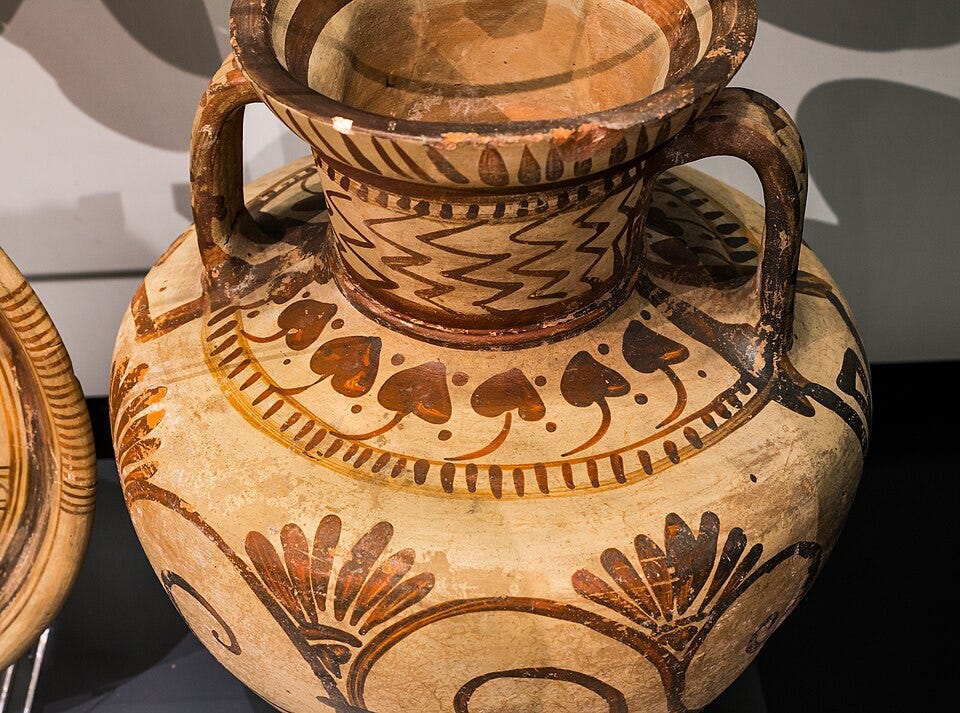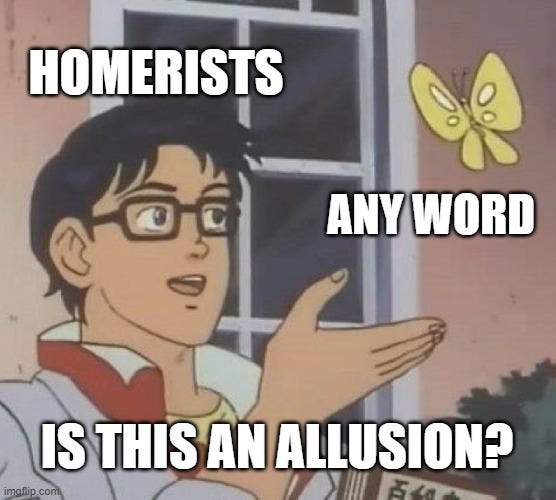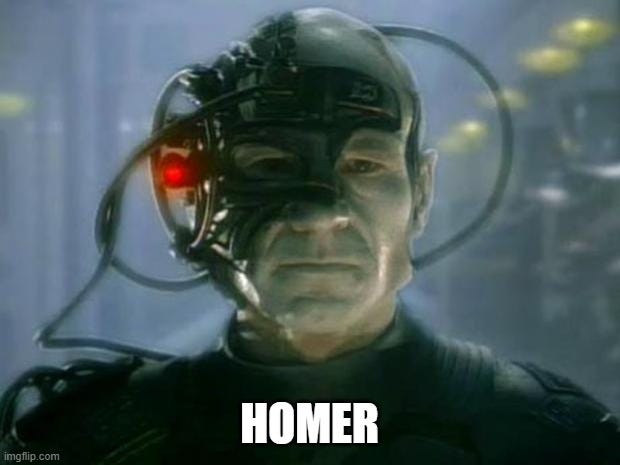This post is a continuation of my substack on the Iliad. All proceeds from the substack are donated to classics adjacent non-profits on a monthly basis. Last year this substack provided over $2k in charitable donations. Don’t forget about Storylife: On Epic, Narrative, and Living Things. Here is its amazon page. here is the link to the company doing the audiobook and here is the press page.
One of the many questions about Homeric poetry that interests me is its engagement with other genres. There are some basic assumptions about how epic works in relation to other kinds of poetry that can restrict how we talk about epic, think about how audiences engaged with the poetry in performance, and how it influenced (and was influenced by) other kinds of song.
Before discussing some of these assumptions, it may be helpful to give some examples of what I mean. First, repeated language (words, formulae, even longer phrases) may not count as intergeneric engagement, since the genres of early Greek poetry really hail from a song culture that shared a special language. While some forms of Greek song are marked by dialectical differences (see Sappho or Corinna, e.g.), Greek poetry leaned on traditional forms and shared language as part of performance culture.
What I mean by intergeneric engagement is when we can see longer lines, motifs, or ideas at play within and across our evidence from Greek performance culture. Here are two examples from Homer and Mimnermus (a poet traditionally placed in the 6th century BCE). Homer, in describing the spirits of deaths has:
Homer, Iliad 12.326-8
“But now, since the spirits of death stand fast around us
By the thousands, and there is no way any mortal can escape them,
Let us go and offer a reason to boast to someone else, or take it for ourselves”νῦν δ’ ἔμπης γὰρ κῆρες ἐφεστᾶσιν θανάτοιο
μυρίαι, ἃς οὐκ ἔστι φυγεῖν βροτὸν οὐδ’ ὑπαλύξαι,
ἴομεν ἠέ τῳ εὖχος ὀρέξομεν ἠέ τις ἡμῖν.
Mimnermus has language that is similar, using the same noun and verb in a combination that an Indo-Europeanist like Calvert Watkins would be “formulaic” in a way that would inform both composition and reception. That is, the noun-verb combination implies a sharing of an image/idea that attends a particular domain. Note, the traditionality of the image in Homer is expanded with more vivid personified language in Mimnermus.
Mimnermus, 2 [=Stobaeus 4.34.12]5-8
“The dark spirits of death are standing beside us.
One holds eventual old age, in pain,
The other has death. The fruit of youth is brief,
As long as the sun’s light stretches across the earth.”…Κῆρες δὲ παρεστήκασι μέλαιναι,
ἡ μὲν ἔχουσα τέλος γήραος ἀργαλέου,
ἡ δ᾿ ἑτέρη θανάτοιο· μίνυνθα δὲ γίνεται ἥβης
καρπός, ὅσον τ᾿ ἐπὶ γῆν κίδναται ἠέλιος.
Another, more famous example, comes from Glaukos’ speech to Diomedes in Iliad 6 where he parries Diomedes’ question about lineage.
Homer, Iliad 6.146-149
The generations of men are just like leaves on a tree:
The wind blows some to the ground and then the forest
Grows lush with others when spring comes again.
In this way, the race of men grows and then dies in turn.οἵη περ φύλλων γενεὴ τοίη δὲ καὶ ἀνδρῶν.
φύλλα τὰ μέν τ’ ἄνεμος χαμάδις χέει, ἄλλα δέ θ’ ὕλη
τηλεθόωσα φύει, ἔαρος δ’ ἐπιγίγνεται ὥρη·
ὣς ἀνδρῶν γενεὴ ἣ μὲν φύει ἣ δ’ ἀπολήγει.
The comparison of the generation of human lives to the growth and shedding of leaves appears as well in Mimnermus.
Mimnermus, fr. 2
“BUT we are like the leaves that spring of many flowers
Produces, when they grow quickly thanks to the sun’s rays”ἡμεῖς δ᾿, οἷά τε φύλλα φύει πολυάνθεμος ὥρη
ἔαρος, ὅτ᾿ αἶψ᾿ αὐγῇς αὔξεται ἠελίου,
In this instance, the comparison is shared, but the language itself doesn’t necessarily lend itself to a formulaic comparison, unless we look at the core comparative word (οἵη/οἷά) + noun (φύλλων/φύλλα) + verb (φύει) sequence as indicative of a common articulation or a generative metaphor that is part of a traditional repertoire of ideas. This takes us right up to those assumptions I mentioned earlier. I’ll separate these into two categories I’ll call “priority trap” and the “generic fallacy”. Both of these categories are rooted in objections I have against supply side poetics–the tendency to privilege authorial intent/practice over what audiences do with poems (songs, etc.).
Let’s start with the priority trap. In my brief comments about Homer and Mimnermus I have operated on the assumption that Homer and Mimnermus draw on a shared corpus of language and image. This is what I would call a networked and non-hierarchical model of reading Greek poetry. It functions in contrast to hierarchical models that imagine Mimnermus “quoting”, “alluding to” or otherwise responding to an extant Homeric text.
Elton Barker and I started to think about these problems two decades ago in our article on the New Archilochus Fragment and Homer. In it, we emphasize that both Homer and Archilochus are likely drawing on shared traditions, using common language to produce different ‘takes’ on shared inheritance. While we believe that Homer was performed/composed prior to Archilochus, we don’t know for sure that the ideas presented within Homer and/or Archilochus were presented in the texts we have for the first time. Indeed, considering the iterative nature of performance culture, it is possible that the texts we have represent ideas that were explored many different times in many different forms. We have no way of actually knowing how the songs engaged with each other over time and how this influenced the final forms we have. This means that it is methodologically as important to ask if Homer is ‘responding’ to Archilochus as it is to invert the question or to consider if they are both responding to something else.
This takes me to another challenge: the generic fallacy. There’s an old and stubborn notion that the poetic genres of ancient Greece had firewalls between them and that there were restrictive rules about the contents and form. All of the imagined rules are eventually undermined: the New Simonides poems showed that elegy could in fact be historical; the new Archilochus demonstrated that elegy could contain narrative myth. (Prior to these publications, very respectable scholars insisted that these poems would not happen).
I have always found restrictions about interpretive flow between and across genres or restrictive use of genres to be suspect. Think of the way people use music today: I have often found myself listening to dance music while doing dishes, exercising, or driving the car. I think this is far from atypical. Song culture in ancient Greece was persistent and permeating, but the boundaries between kinds of songs and their occasions were not fixed and hard. Instead, they moved and were squishy, accommodating audience use and changing cultures over time.
I started thinking about this recently because I have been reading Stephen A. Sansom’s article “Achilles and The Resources of Genre: Epitaph, Hymnos, and Paean in Iliad 22.386-94”. In it, Sansom builds on an earlier article by Christopher Faraone, proposing that Homeric singers integrated other hexametric genres into their creations. Farone suggests that singers do this in order “to enhance a dramatic or narrative situation by fulfilling or upsetting the audience’s generic expectations.” Faraone uses literary theory (Bakhtin) to talk about embedded genres (similarly Melissa Mueller uses Eve Sedwick’s reparative reading to talk about Sappho and Homer). I am a big fan of theoretical approaches, especially when they undergird a pragmatic reality. In this case, I am not sure we need literary theory to make a very basic proposition: Greek singers used the full range of language, music, and ideas at their disposal in order to engage with their audiences. It is my belief that as a ‘master genre’ of Greek song, Homeric epic regularly absorbed and integrated features from other genres.
I first started thinking about this when working on my dissertation and reading A. P. Lardinois’ work on the integration of proverbs into Greek epic. If we can ignore questions of priority and disregard the restrictive definition of genre that posits that elegy and epic and lyric are different poetic universes, it is easier to imagine a performance context where an epic rhapsode would adapt or otherwise integrate words, sounds, and ideas from other forms that audiences would know.
There is an interpretive payoff for this at micro-and macro levels. Sansom shows that Achilles uses language akin to hymnic epitaphs in thinking about Patroklos, indicating a characterization of Achilles that shows a consciousness of other genres and a humanizing move: the hero reflects on death the way ancient audiences did with their funerary epitaphs. This has a reinforcing as well as reflective impact on the shared culture of audience and song. There are structural aspects to this as well indicating group and individual songs, the beginning and end of ritual, and the overall shape and arc of the poem. Here’s what Sansom says
Achilles’ call for the paean in Book 22 repeats most of line 1.473 (ἀείδοντες παιήονα κοῦροι Ἀχαιῶν, the only other instance in the epic corpus) and seeks to inspire a similar or perhaps the same group of Achaians to sing (υἷες Ἀχαιῶν, 22.369; κοῦροι Ἀχαιῶν, 22.391). Considering the generic qualities of Achilles’ recollection of Patroklos, hymnos also precedes and works in conjunction with both paeans. From a wider view, then, we can observe that the Iliad thus begins and initiates its ending with embedded hymns: the first, a hymn from local cult; the second, a hymnic epitaph that prototypes the hero-cult of Patroklos. In doing so, it makes use of two of the formal functions associated with hymns: that of preface or prooimion in the epichoric hymn of Book 1, and as a transitional device between songs, themes, or locales in Achilles’ hymn of Book 22.'
There’s a lot more detail to support his argument–the whole piece is certainly worth reading. This joins a growing body of work that acknowledges that Homeric poetry is in a way trans-generic, or, perhaps less clunkily, that the genre of epic poetry is actively engaged with other song genres. Of course, there is a less positive way to think about it as well. As Elton and I have argued in Homer’s Thebes, there is a leveling, almost imperial character to Homeric poetry as it exerts its force on other genres. Like the Star Trek’s Borg, Homeric epic seeks to integrate themes and ideas from other traditions into its song, which it means to make the final one. And, resistance can indeed be futile: Homeric poetry makes its meaning as much by silencing ideas as sampling them.
A Short Bibliography on Homer and Other Genres
Alexandrou, Margarita. “Mythological narratives in Hipponax.” Iambus and elegy : new approaches. Eds. Swift, Laura and Carey, Chris. Oxford ; New York: Oxford University Pr., 2016. 210-228.
Baratz, Amit. “The roots of divination in archaic poetry.” Classical Philology, vol. 117, no. 4, 2022, pp. 581-602. Doi: 10.1086/721576
Barker, Elton and Christensen, Joel. “ the new Archilochus fragment and its resonance with Homeric epic.” Materiali e Discussioni per l’Analisi dei Testi Classici, no. 57, 2006, pp. 9-41.
Blondell, Ruby. “Refractions of Homer's Helen in archaic lyric.” American Journal of Philology, vol. 131, no. 3, 2010, pp. 349-391.
Currie, Bruno. Homer’s allusive art. Oxford: Oxford University Pr., 2016.
Dalby, Andrew. “ lyric and epic in the seventh century.” Archaic Greece: new approaches and new evidence. Eds. Fisher, Nick and Van Wees, Hans. London: Duckworth, 1998. 195-211.
Evans, Stephen. Hymn and epic: a study of their interplay in Homer and the « Homeric Hymns ». Annales Universitatis Turkuensis. Ser. B, Humaniora; 244. Turku: Turun yliopisto, 2001.
Faraone, Christopher A.. “On the eve of epic : did the Chryses episode in Iliad 1 begin its life as a separate Homeric « Hymn » ?.” Persistent forms : explorations in historical poetics. Eds. Kliger, Ilya and Maslov, Boris. Verbal Arts : Studies in Poetics. New York: Fordham University Pr., 2016. 397-419. Doi: 10.5422/fordham/9780823264858.003.0015
Griffith, Mark. “Man and the leaves, a study of Mimnermos fr. 2.” California Studies in Classical Antiquity, vol. VIII, 1975, pp. 73-88. Doi: 10.2307/25010683
Harden, Sarah J. and Kelly, Adrian. “Proemic convention and character construction in early Greek epic.” Harvard Studies in Classical Philology, vol. 107, 2013, pp. 1-34.
Hendricks, Amy N.. Approaching chorality : literary representations of the chorus in archaic Greek poetry. [S. l.]: [s. n.], 2020.
Janko, Richard (2016). the archetype of the Orphic gold leaves. Classical Quarterly, N. S., 66(1), 100-127. Doi: 10.1017/S0009838816000380
Kousoulini, Vasiliki. “Alcmanic Hexameter: Alcman’s poetry in its oral context.” Greek, Roman and Byzantine Studies, vol. 53, no. 3, 2013, pp. 420-440.
Lardinois, André Pierre M. H.. “ the orality of Greek proverbial expressions.” Speaking volumes: orality and literacy in the Greek and Roman world. Ed. Watson, Janet. Mnemosyne. Supplements; 218. Leiden ; Boston (Mass.): Brill, 2001. 93-107.
Lardinois, André Pierre M. H.. “Characterization through gnomai in Homer's « Iliad ».” Mnemosyne, vol. 53, no. 6, 2000 Ser. 4, pp. 641-661.
Lavigne, Donald. “Archilochus and Homer in the rhapsodic context.” Iambus and elegy : new approaches. Eds. Swift, Laura and Carey, Chris. Oxford ; New York: Oxford University Pr., 2016. 74-98.
Larson, Stephanie. “ τεθνάκην δ᾽ἀδόλως θέλω: reading Sappho’s « confession » (fr. 94) through Penelope.” Mnemosyne, Ser. 4, vol. 63, no. 2, 2010, pp. 175-202. Doi: 10.1163/156852510X456129
Levaniouk, Olga Arkadievna. “« Αἴθων », Aithon, and Odysseus.” Harvard Studies in Classical Philology, vol. 100, 2000, pp. 25-51.
Lulli, Laura. “Elegy and epic : a complex relationship.” Iambus and elegy : new approaches. Eds. Swift, Laura and Carey, Chris. Oxford ; New York: Oxford University Pr., 2016. 193-209.
Martin, Richard P.. “ enigmas of the lyric voice.” Making silence speak: women's voices in Greek literature and society. Eds. Lardinois, André Pierre M. H. and McClure, Laura K.. Princeton (N. J.): Princeton University Pr., 2001. 55-74.
Maslov, Boris. “The genealogy of the Muses: an internal reconstruction of archaic Greek metapoetics.” American Journal of Philology, vol. 137, no. 3, 2016, pp. 411-446.
Mueller, Melissa. “ Re-centering epic « nostos »: gender and genre in Sappho’s Brothers poem.” Arethusa, vol. 49, no. 1, 2016, pp. 25-46.
Mueller, Melissa. Sappho and Homer: A Reparative Reading. Cambridge. 2023.
Nobili, Cecilia. “ il nuovo Archiloco.” Maia, vol. 61, no. 2, 2009, pp. 229-249.
Nobili, Cecilia. “Female lyric voices in the « Odyssey ».” Philologia Antiqua, vol. 16, 2023, pp. 65-81. Doi: 10.19272/202304601006
Purves, Alex. “Who, Sappho ?.” Defining Greek narrative. Eds. Cairns, Douglas L. and Scodel, Ruth. Edinburgh Leventis Studies; 7. Edinburgh: Edinburgh University Pr., 2014. 175-196.
Sbardella, Livio. “The Trojan War Myth: rhapsodic canon and lyric alternatives.” Submerged literature in ancient Greek culture: an introduction. Eds. Colesanti, Giulio and Giordano, Manuela. Berlin ; Boston (Mass.): De Gruyter, 2014. 61-75.
Strauss Clay, Jenny. “The new Simonides and Homer's ἡμίθεοι.” The new Simonides: contexts of praise and desire. Eds. Boedeker, Deborah and Sider, David. Oxford ; New York: Oxford University Pr., 2001. 182-184.
Swift, Laura. “Negotiating seduction : Archilochus’ Cologne epode and the transformation of epic.” Philologus, vol. 159, no. 1, 2015, pp. 2-28.
Toohey, Peter. “Archilochus' general (fr. 114 W). Where did he come from?.” Eranos, vol. LXXXVI, 1988, pp. 1-14.
Walsh, Thomas R.. “Some refractions of Homeric anger in Athenian drama.” A Californian hymn to Homer. Ed. Pepper, Timothy. Hellenic Studies; 41. Cambridge (Mass.): Harvard University Pr., 2010. 105-129.
Watkins, Calvert. “Let us now praise famous grains.” Proceedings of the American Philosophical Society, vol. CXXII, 1978, pp. 9-17.
Watkins, Calvert. How to Kill a Dragon: Aspects of Indo-European Poetics. 1995.
Węcowski, Marek. “Homer and the origins of the symposion.” Omero tremila anni dopo: atti del Congresso di Genova : 6-8 luglio 2000. Eds. Montanari, Franco and Ascheri, Paola. Storia e Letteratura; 210. Roma: Ed. di Storia e Letteratura, 2002. 625-637.





I assume you mean "uses", not "useless" ...
On a more serious note, I've never subscribed to the fallacies of thematically fixed genres that you mention, not least because, as someone of a far older generation from you, my touchstone when thinking about genre in any culture is still Alastair Fowler, Kinds of Literature (Harvard, 1982), which (inter alia) makes the readers' experience central to the entire conception of what a "genre" is in the first place. Do you know that book - and if so, have you found it useful for these kinds of questions in archaic Greek literature?